By Clement Kent

- Francis Bacon, Novum Organum, 1620.
This started off to be an article about George Ordish and his immensely erudite books on pests and gardens, but somewhere along the way my attention wandered for a moment. I blame Mr. Ordish - his capsule biography of Francis Bacon, thrown in just for the fun of it, was just as digressive as this article turned out to be. Ordish was after all supposed to be writing a history of pests and pest control. How exactly this relates to Bacon's life and death I had better let Mr. Ordish tell you:
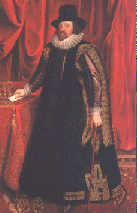
"...the Baconian method...was to make experiments and accumulate facts, difficult though both might be. It was an attempt to accumulate facts that led to Bacon's death. He had an idea that cold would preserve food, and one winter day went out into the snow to fill a newly killed chicken with it. He caught pneumonia and died. [...] He was not, apparently, a likeable man and his wife seemed to bear his death with equanimity; she married again a week later." 1.
The cruel Mr. Ordish, after tantalizing us with these few facts about Bacon, drops him and proceeds to the naturalists who were inspired by writings like those of Bacon, to investigate the natural world more closely. The invention of the microscope allowed naturalists to see a realm of Nature previously unguessed. Ordish informs us that the first drawings from microsopic observations were of bees and weevils "by the Academy of the Lynx in 1625 and these were better printed a little later by Francesco Stellati in 1630".
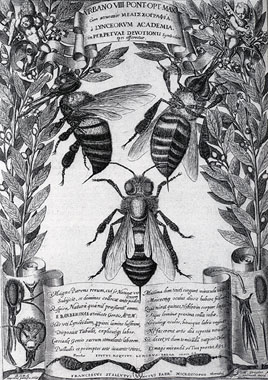
I have a professorial friend who is passionate about bees, so I immediately wondered if I could find some of these drawings for him. And the association with the "Academy of the Lynx" intrigued me. It pleased me then to find the title page to Francesco Stelluti's book "Melissographia" on the web in an exhibition of books from the Vatican Library. Stelluti (Ordish misspelled his name as "Stellati") was a founding member of the Accademia dei Lincei, a group of free-spirited young men who wished to free inquiry into nature from the bondage of scholastics "who have presumed to dogmatize on Nature", as Bacon complains. The lynx has a reputation as being sharp-eyed and far-seeing, thus their name.
Beginning in 1603, the Lincei met sporadically, braving parental disapproval of what was viewed as unbecoming behavior. Gradually the fame of the academy spread. Well known natural philosophers such as Galileo joined (in 1611). The members of the Academy later came to Galileo's defense when he ran into trouble with the Church.
The study of plants was important to the Academy, especially as plants were then the source of most medications. A book on botany by Fabricio Colonna was published by the Lynxes. Prince Cesi, the most influential Academician, funded the publication of an attempt to classify the plants of the world, the Phytophysicae Tabulae, with Stelluti doing most of the work. This was embedded in a larger work issued in 1628 by the Academy, the Rerum Medicarum Novae Hispaniae Thesaurus. Therein lies a story for those authors who despair of ever seeing their work published.
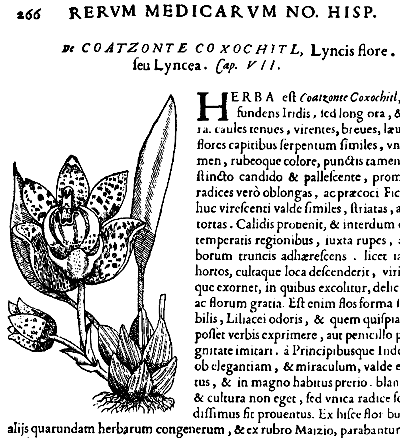
The history of the European subjugation of New World native peoples is a long and sad one which is only now beginning to be fully researched and told. From the plant lover's point of view, one especially sad chapter is the loss of the knowledge of plants that some of the most sophisticated New World cultures had before the European invasions. A few enlightened souls tried hard to preserve this knowledge. Doctor Francisco Hernandez became "First Physician of the Indes" and set sail for Mexico in 1570:
When he reached the New World he found the Aztecs had already devised a system of naming plants, which took into account their habitat and properties. HernŠndez enlisted native guides, artists, herbalists, and physicians to teach him about the materia medica of the country. He was impressed with the fact that the Aztecs had developed extensive botanical gardens and zoos, and had created collections of natural oddities and minerals. As a result, HernŠndez was able to obtain a clear picture of Mexico's natural history. 2.
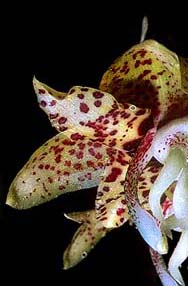 Hernandez wrote up his studies of the plant lore of the Aztecs in Rerum Medicarum Novae Hispaniae.
He put his own money into publication and made sure copies were left behind in Mexico, none of which survived.
The copy he presented in 1677 to Spanish King Philip was sumptuously bound, and placed in the Escorial Library
where it was largely inaccessible to most scholars. The King for a long time refused to publish the book
and Hernandez died 10 years later with his pioneering work still largely unknown. Eventually the king
agreed to allow extracts from the book to be copied, but publication continued to be delayed until
the Accademia dei Lincei bought the partial manuscript and published it in 1628, 51 years late!
Hernandez wrote up his studies of the plant lore of the Aztecs in Rerum Medicarum Novae Hispaniae.
He put his own money into publication and made sure copies were left behind in Mexico, none of which survived.
The copy he presented in 1677 to Spanish King Philip was sumptuously bound, and placed in the Escorial Library
where it was largely inaccessible to most scholars. The King for a long time refused to publish the book
and Hernandez died 10 years later with his pioneering work still largely unknown. Eventually the king
agreed to allow extracts from the book to be copied, but publication continued to be delayed until
the Accademia dei Lincei bought the partial manuscript and published it in 1628, 51 years late!

The illustration above from Rerum is the first European depiction of a tropical orchid. Hernandez called it the "Lynx flower", but the modern name is Stanhopea hernandezii. The reference to the Lynx was probably based on the spotting of the flowers and their color scheme. It is an odd coincidence of history that this description of the "Lynx flower of the Lynxes" was saved by the Academy of the Lynxes from oblivion - for the only complete copy of Hernandez' book was destroyed in a fire in the Escorial Library in 1671. (The Spanish Lynx we show here is now on the verge of extinction).
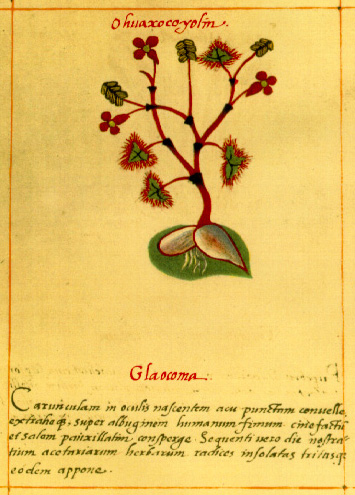
Rerum Medicarum Novae Hispaniae and a few other works from that time have thus preserved what little we now know of the sophisticated Aztec understanding of plants and their uses. One of the most interesting of these works is the Badianus Manuscript, or Codex Barberini, held in te Vatican Library. This was the work of two Aztecs who both knew their own culture's botany and herbology and had been trained in Latin at the College of Santa Cruz. The text in both Aztec and Latin has 204 illustrations of herbs and trees, grouped by their medicinal uses.

The great city of Tenochtitlan amazed the Spaniards with its vast gardens laid out systematically in squares with trellises for vines and other plants brought from far away. It has been suggested that reports of these Aztec gardens spurred the establishment of the first European botanical gardens in the 1540's.
The herbal simples in the great botanical gardens of Tenochtitlan had many uses. Aztecs used the Lynx flower to treat sunstroke, while the Badianus manuscript mentions the use of that most important orchid, Vanilla planifolia, as spice, as flavoring or as a general potion for good health.
Vanilla was cultivated for its long seedpods by the Totonac tribe of Mexico before the Aztecs rose to power. It is said that
"the Tontonacas still grow Vanilla vines with almost religious devotion because to them it was the gift of the gods... Vanilla is a pleasant, aromatic aphrodisiac. Old Totonac lore has it that Xanat, the young daughter of the Mexican fertility goddess, loved a Totonac youth. Unable to marry him due to her divine nature, she transformed herself into a plant that would provide pleasure and happiness. She became the vanilla orchid so that she could forever belong to her human love and his people. The local people still celebrate the Vanilla Festival at the end of the harvest with dances and feasts."
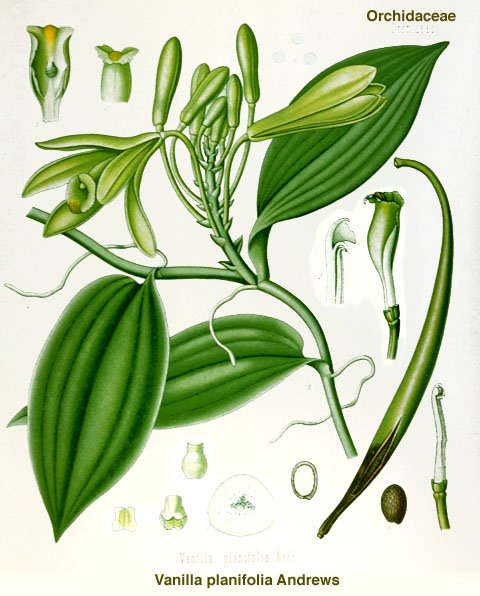
Is Vanilla an aphrodisiac? The Aztecs thought so. An integral part of the royal drink "chocolatl" was vanilla. When Cortez visited the court of Emperor Montezuma of Mexico, he found that Montezuma
"took no other beverage than the chocolatl, a potation of chocolate, flavored with vanilla and spices, and so prepared as to be reduced to a froth of the consistency of honey, which gradually dissolved in the mouth and was taken cold." The fact that Montezuma consumed his "chocolatl" in goblets before entering his harem led to the belief that it was an aphrodisiac.
The belief in the aphrodisiac qualities of Vanilla persists to this day, although its popularity as a flavoring for children's sweets suggests other qualities may be more important.
Vanilla flowers only set seed naturally in their home range in the subtropical forests of Central America. Although the plant is now grown extensively in Madagascar and other African islands, it must be hand pollinated there. Like many orchids, it turns out Vanilla planifolia is exquisitely co-adapted to a pollinator, a Melponine bee, found only in its homeland. It is this kind of specialised adaptation that renders many species of orchids vulnerable to extinction in the wild. Not only is their habitat being reduced daily by forest clearance, but their coevolved pollinators are at risk of extinction as well. If the pollinator goes, the orchid goes too.
From Bacon to Bees, Lynxes to Aphrodisiac Orchids, and back to Bees we have gone. Ordish himself enjoyed and indulged in Shandyesque wanderings, as this quotation from the introduction to his book The Living American House makes clear:
"The reader must not expect in this work merely the private uninteresting history of a single person. He may expect whatever curious particulars can with any propriety be connected with it. Nor must the general disquisitions and the incidental narratives of the present work be ever considered as actually digressionary in their natures, and as merely useful in their notices. They are all united with the rest, and form proper parts of the whole." 3.
1. Ordish, George. The Constant Pest. New York: Scribner's, 1976 (pp. 50-51)
2. http://www.rentahost.net/orchildnights/content/Hernandez.html
3. J. Whitaker, History of Manchester (1771-1775) - quoted in Ordish, George. The Living American House New York: William Morrow, 1981 (pp. 15)
Copyright 2001 by Clement Kent, c l e m e n t @ g o d e l . n e t